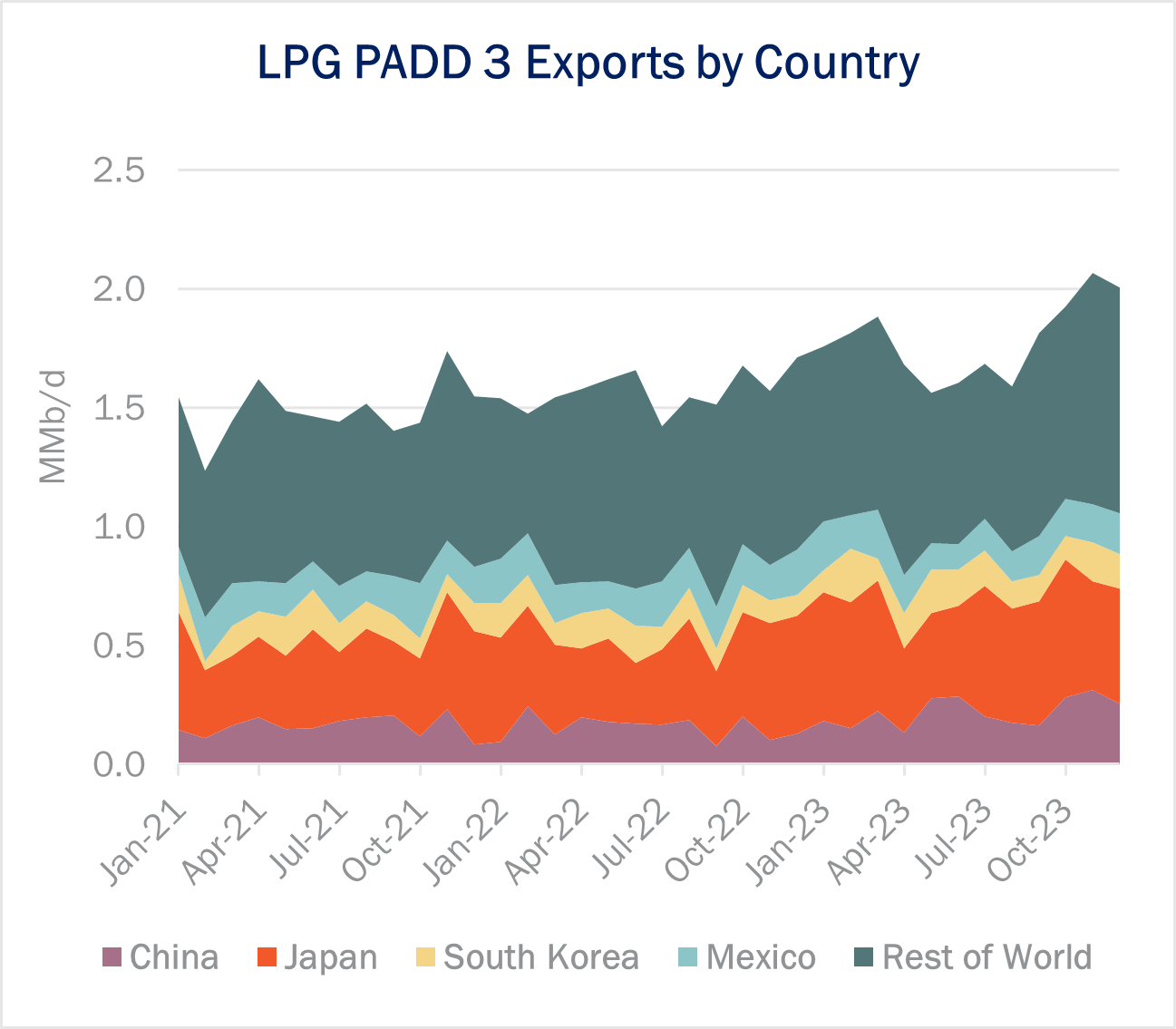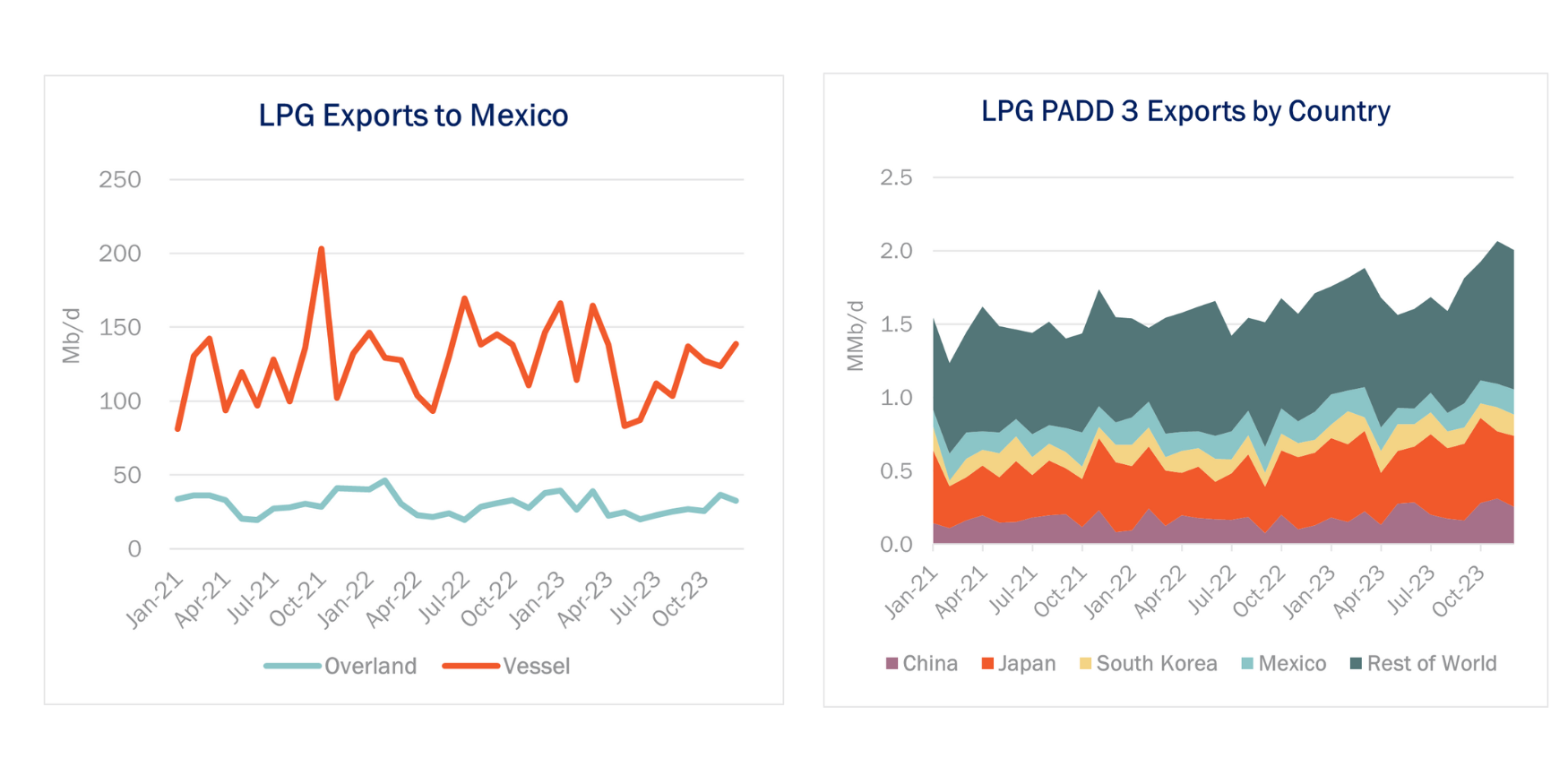Several market factors could support additional growth in liquefied petroleum gas (LPG) exports despite tightness at Gulf Coast docks.
East Daley Analytics recently highlighted how the lifting of a nighttime transport ban has increased operating capacity at some LPG docks on the Houston Ship Channel (HSC). 24×7 piloting raises potential exports by an estimated 5-10% for operators like Targa Resources (TRGP) and Enterprise Products (EPD) at a time when spare capacity is scarce, according to the NGL Network Model.


Another factor that could provide a relief valve is Mexico. About 10% of total LPG exports are destined to our neighbors to the south (see light blue area of Figure 1). From 2021 to 2023, exports to China, Japan, and South Korea grew at a CAGR of 17%, 15% and 10%. By contrast, Mexico’s demand for US propane and normal butane has been stable at ~155-160 Mb/d.
Based on industry discussions, we understand LPGs transported to northern Mexico are sent via rail while exports to southern Mexico are loaded onto LPG vessels. According to Union Pacific, two major railroads operate in Mexico: Ferromex (FXE) and Canadian Pacific Kansas City (CPKS). FXE has two cross-border locations in Texas, one in El Paso and one at Eagle Pass. CPKC has cross-border locations in Laredo and Brownsville, TX.
In Figure 2, East Daley assumes LPG exports at El Paso and Laredo (as captured in US Customs data) are moved by truck or rail, while LPG exports at Houston and Port Arthur are loaded onto vessels. If our assumptions are correct, volumes of propane and butane railed to northern Mexico total about 30 Mb/d.
If we are correct, then overland transport doesn’t appear to offer much upside in working around the LPG dock bottleneck. Between 24×7 HSC piloting and a small slice of exports traveling overland, EDA could only uncover at total of 130 Mb/d of additional “effective” LPG dock capacity in PADD 3 for consideration in the NGL Network Model. – Rob Wilson Tickers: EPD, TRGP.
New CAPEX Dashboard Creates Superior Visibility into Midstream Budgets
East Daley is excited to launch our latest product, the CAPEX Dashboard, offering superior visibility into midstream investments. The CAPEX Dashboard provides detailed breakdown of capital projects by commodity, geography and asset type, allowing users to effectively track sector trends, analyze individual companies or compare with peers. Learn more about the CAPEX Dashboard here.
Sign Up for the Crude Oil Edge
East Daley’s Crude Oil Edge provides weekly updates on the US crude oil market including supply and demand fundamentals, basin-level views, and analysis of market constraints and infrastructure proposals. We explore sub-basin dynamics and provide market insights on crude oil flows, production growth, and import and export characteristics. Sign up now for the Crude Oil Edge.
New EDA Product: Houston Ship Channel Supply & Demand
The Houston Ship Channel Supply & Demand report allows users to dive deep in understanding, and monitoring Houston Ship Channel natural gas dynamics. The product contains monthly updates of relevant price spreads, pipeline flows, production and demand estimates affecting the South Texas market, with forecasts extending 5 years into the future. Learn more about the Houston Ship Channel Supply & Demand report.
Energy Data Studio
East Daley Analytics has launched Energy Data Studio, a platform for our industry-leading midstream data and commodity production forecasts. All clients have access to the new client portal. If you have not yet logged in, please fill out the form to request a registration email be resent.
Energy Data Studio leverages our G&P data set for insights into midstream assets across every major oil and gas basin in North America. Users can navigate detailed visual dashboards by region, pipeline, or individual asset to understand crude oil, natural gas and NGL supply at the most granular level.
Energy Data Studio is available through data downloads from the visual interface, in Excel files, or as a direct feed delivered into subscribers’ workflow via secure file transfer. To learn more about Energy Data Studio, please contact [email protected].
The Daley Note
Subscribe to The Daley Note (TDN) for midstream insights delivered daily to your inbox. The Daley Note covers news, commodity prices, security prices and EDA research likely to affect markets in the short term.


